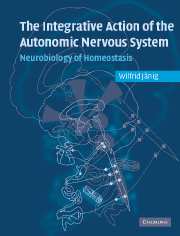Book contents
- Frontmatter
- Contents
- Foreword
- Preface
- List of abbreviations
- Introduction
- Part I The autonomic nervous system: functional anatomy and visceral afferents
- Chapter 1 Functional anatomy of the peripheral sympathetic and parasympathetic nervous system
- Chapter 2 Visceral afferent neurons and autonomic regulations
- Part II Functional organization of the peripheral autonomic nervous system
- Part III Transmission of signals in the peripheral autonomic nervous system
- Part IV Central representation of the autonomic nervous system in spinal cord, brain stem and hypothalamus
- References
- Index
Chapter 1 - Functional anatomy of the peripheral sympathetic and parasympathetic nervous system
Published online by Cambridge University Press: 10 August 2009
- Frontmatter
- Contents
- Foreword
- Preface
- List of abbreviations
- Introduction
- Part I The autonomic nervous system: functional anatomy and visceral afferents
- Chapter 1 Functional anatomy of the peripheral sympathetic and parasympathetic nervous system
- Chapter 2 Visceral afferent neurons and autonomic regulations
- Part II Functional organization of the peripheral autonomic nervous system
- Part III Transmission of signals in the peripheral autonomic nervous system
- Part IV Central representation of the autonomic nervous system in spinal cord, brain stem and hypothalamus
- References
- Index
Summary
Before developing the general concepts of the function of the autonomic nervous system and describing its neurobiology I will describe some aspects of the anatomy and function of this system on the macroscopic level and explain the limitations of our present understanding. Furthermore, I will provide some definitions. This conventional approach is necessary to help to convey what is meant when we speak of how the peripheral autonomic nervous system behaves and to lay the groundwork for the description of the functions in which the autonomic nervous system is involved.
Definitions and limitations
Langley (1900, 1903a, b, 1921) originally proposed the generic term autonomic nervous system to describe the system of nerves that regulates the function of all innervated tissues and organs throughout the vertebrate body except striated muscle fibers; that is, the innervation of the viscera, vasculature, glands, and some other tissues. This term is synonymous with the term vegetative nervous system, which has become obsolete in Anglo-American countries. However, the latter is still the preferred term in German (“vegetatives Nervensystem”; Jänig 2005a), French (“système végétative”), Italian (“systema neurovegetativo”), Spanish (“sistema nervioso vegetativo”) and Russian (“vegetativnaia nervnaia systema”). Langley (1921) divided the autonomic nervous system into three parts: the parasympathetic nervous system, the sympathetic nervous system and the enteric nervous system. This definition has stood the test of time and is now universally used in descriptions of the autonomic nervous system in vertebrates (Nilsson, 1983; Gibbins, 1994).
- Type
- Chapter
- Information
- Integrative Action of the Autonomic Nervous SystemNeurobiology of Homeostasis, pp. 13 - 34Publisher: Cambridge University PressPrint publication year: 2006
- 6
- Cited by



